Table of Contents
H ow To Play
GUITAR
A Complete Guide
for Absolute Beginners
Ben Parker
Author: Ben Parker
Editor: Alison McNicol
First published in 2012 by Kyle Craig Publishing
Text and illustration copyright 2012 Kyle Craig Publishing
Design and illustration: Julie Anson @ The Great Little Design Co.
Music set by Ben Parker using Sibelius software
ISBN: 978 -1-908-707-09-3
A CIP record for this book is available from the British Library.
A Kyle Craig Publication
www.kyle-craig.com
All Rights Reserved.
No part of this publication may be reproduced, stored in a retrieval system or transmitted by any form or by any means, electronic, recording or otherwise without the prior permission in writing from the publishers.
Unauthorised reproduction of any part of this publication by any means including photocopying is an infringement of copyright.
INTRODUCTION
Welcome to How To Play Guitar . The Guitar is probably the most popular instrument for beginners who wish to start playing a string instrument.
In this book we aim to give you your first simple steps to playing which can act as a basis for a bright future with the instrument. Also included in the book is a step by step guide to reading music.

PRACTICE
Like any skill, playing an instrument takes a lot of practice. Practicing more regularly for shorter lengths of time is more effective than practicing for an hour or so just once a week. The minimum amount would be around 15-20 minutes, 3 to 4 times a week. The ideal amount would be 20 minutes a day, 7 days a week. Maybe set out a plan of your week and work out the best times to fit your practicing around the other things you do. The more your practice can become part of your weekly or daily routine the better.

ABOUT THE GUITAR
The guitar originates from a group of European string instruments played in the 12 th century. The guitar as we know it today began taking its current form in the 15 th and 16 th centuries when a Spanish instrument called a Vihuela was developed. Like a medieval Lute, the Vihuela had six strings and a curved body.

The guitar comes in many types, shapes and sizes. The most popular types of guitar used today are steel string acoustic guitars and electric guitars, although beginners often begin by playing a nylon string (or Classical) guitar.
On the guitar you can play both chords and single notes, strum and pick. These different ways of playing make it an interesting instrument to learn, with different stages of ability as your skills progress.

THE INSTRUMENT

HOW TO HOLD THE GUITAR
As a beginner you are likely to feel the most comfortable playing sitting down, with the curve of the guitar body resting on your right leg. Make sure you choose a seat or stool that allows your feet to sit flat on the floor. If you have a strap you can also try playing standing up.

WHAT TO DO WITH YOUR HANDS
Left Hand Position
Your left hand position is really important. Make sure your thumb is around the back of the neck. When you fret a note it should be like pinching the neck between your thumb and forefinger. Fretting will be explained in more detail later on in the book.
Right Hand Position
Your right arm will naturally hang over the body of the guitar, dropping your right hand down to where the strings are. To begin with you should rest your thumb on the bottom (thickest) string and pull up on the strings to pluck them. Alternatively you can use a pick or plectrum.
Left Handed Players
Some left handed players play the guitar right-handed. If you are left-handed try the playing position shown and see how it feels. If it feels strange, try playing it the other way round (with the guitar headstock pointing to your right) if this position feels more comfortable then you will need to have the guitar re-strung upside down. Ask at your local music store they should be able to do this for you.

USING A PLECTRUM / PICK
You can use your right hand fingers to play the guitar but many players use a plectrum (often called a pick) to strum chords and pick single notes. It is best to strum across the soundhole of the guitar. If strumming with your fingers (without a pick) use your thumb to strum downwards and your fingers for the upstroke.
Picks come in different thicknesses. A pick of medium thickness (nylon .60mm) is probably the best place to start. A brighter tone can be produced with a pick and most players find it easier to move swiftly between playing chords and single notes when using one. There will also be more about picking the strings with your right hand fingers later on in the book.

STRINGS AND THINGS
Caring For Your Guitar
You can keep the body of your guitar clean using a polishing cloth and some (wooden) furniture polish. This should get rid of any smears or fingerprints from handling the guitar. You can also wipe the strings down too. Hold a clean cloth (not a polishing cloth) and pinch the string between your thumb and index finger and run your pinched fingers the whole length of the string. This should get rid of any grease that builds up from sweat etc. whilst playing.





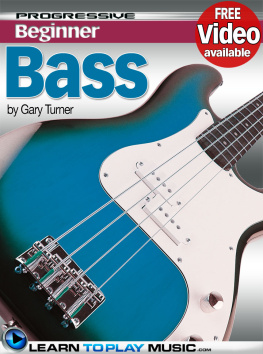
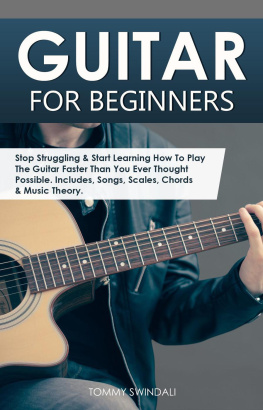
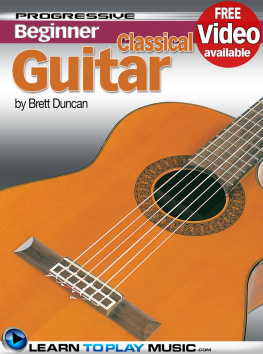
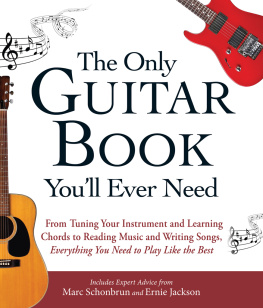

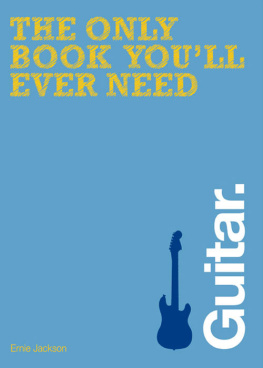
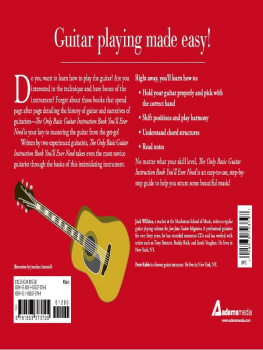



 PRACTICE
PRACTICE
 ABOUT THE GUITAR
ABOUT THE GUITAR The guitar comes in many types, shapes and sizes. The most popular types of guitar used today are steel string acoustic guitars and electric guitars, although beginners often begin by playing a nylon string (or Classical) guitar.
The guitar comes in many types, shapes and sizes. The most popular types of guitar used today are steel string acoustic guitars and electric guitars, although beginners often begin by playing a nylon string (or Classical) guitar. THE INSTRUMENT
THE INSTRUMENT
 HOW TO HOLD THE GUITAR
HOW TO HOLD THE GUITAR
 WHAT TO DO WITH YOUR HANDS
WHAT TO DO WITH YOUR HANDS

 USING A PLECTRUM / PICK
USING A PLECTRUM / PICK
 STRINGS AND THINGS
STRINGS AND THINGS